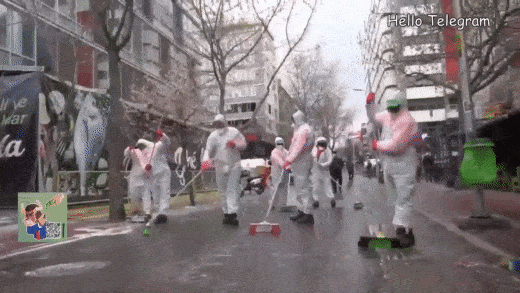
Sanitation workers across the world have been seen spraying public outdoor spaces like streets, parks, and plazas with diluted solutions of bleach. The reasoning is that by disinfecting the streets, the coronavirus is less likely to infect people who venture outside.
The problem is that this reasoning is severely flawed. Disinfecting streets and other outdoor public venues is, by and large, useless and a complete waste of public resources. You might as well spray dollar bills, the effect is the same: lots of money lost and nothing done to actually curb the spread of the virus.
Just take a look at this ludicrous 3-minute collage of footage showing street disinfection across the world, from Turkey to Venezuela.
However, that’s not to say that spraying the streets with bleach doesn’t serve a purpose. Like in most matters of wasted tax-payers’ money, this sort of operation — either ordered out of ignorance or for political capital — gives the impression that authorities are actually doing something. In turn, the public has a sense that it is looked out for.
Why disinfecting outdoor public spaces is a bad idea
Although disinfecting the outdoor spaces in densely populated urban areas might seem like almost a sensible idea, this completely misses the science of the coronavirus transmission.
First and foremost, SARS-CoV-2 spreads through direct contact with airborne droplets and aerosols originating from infected individuals. A susceptible host can become ill with COVID-19 when an infected person in close proximity coughs, sneezes, or even speaks towards our face.
When droplets containing active viral material touch our face or hands, the virus can get inside the body through the nose, mouth, or eyes, thereby infecting the host.
The secondary mode of transmission is via contaminated surfaces. You might touch a bus rail or doorknob that was previously contaminated with droplets containing the virus. If you then touch the mouth, nose, or eyes, you risk becoming infected.
An often-cited study suggests that the virus can remain viable for 72 hours on plastic and stainless steel, 8 hours on copper, and 4 hours of cardboard and other porous surfaces.
However, this study was performed under controlled laboratory conditions and doesn’t capture the full scope of ‘real world’ conditions. What’s more, the study did not assess the risk of infection following contact with said surfaces.
Scientists have found that direct sunlight kills the coronavirus. Temperature and humidity are also important factors that determine the viability of the virus — the higher these two are, the less able the virus is at infecting people.
In other words, nature is already doing us a favor by offering free disinfection. So, why bother disinfecting the streets?
While it is true that the coronavirus can stay active on various surfaces, how often do you touch the pavement with your hands or face? Not very often, I’d wager.
Perhaps a better idea would be to disinfect commonly touched surfaces such as road-crossing buttons. However, this is, again, useless. For instance, disinfecting a handrail destroys any trace of the virus from the previous contact, but the process needs to be repeated the next time an infected person touches the surface.
Spraying the atmosphere? That’s maybe even worse
Aerosols are essentially particles small enough to remain suspended in the air. Aerosols can carry viruses, which can infect susceptible hosts when inhaled.
Spraying disinfectant in the air can reduce the amount of virus that is suspended as aerosols. However, the practice is highly inefficient since the droplets of bleach rapidly disperse, falling to the ground. What’s more, after disinfection is complete, an infected person could walk through the same area at any time, spreading more viral aerosols. So, this is yet another futile effort.
Just for show
Spraying disinfectant in urban areas is extremely ineffective. What’s more, such practices introduce additional risks to public health because bleach and other disinfectants can cause adverse effects when inhaled.
Bleach can burn the skin and eyes, which is why people spraying it usually wear protective equipment. It can also trigger respiratory conditions among those who are often exposed to it.
And, urban disinfection en masse can instill a false sense of security to the public. People strolling through a recently disinfected plaza or street might be less cautious than they usually would have been (i.e. they might not wear a mask).
Spraying city streets has more to do with giving the impression that authorities are on top of things than actually enforcing sound public health policy.
The reality is that the only viable means to protect ourselves from the virus is personal responsibility. This means being careful to be physically apart from other people when leaving the house, wearing a mask in public, and thoroughly washing hands with an alcohol-based solution or soap as often as possible.









